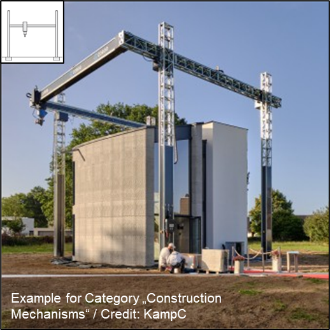Research Summary Report of C06
Integration of Additive Manufacturing in the Construction Process
[06.10.2022]
Placzek, Gerrit; Doctoral researcher, g.placzek@tu-braunschweig.de
TU Braunschweig, IBB
The integration of additive manufacturing into construction requires an interdisciplinary approach. The different competences of the team – digital fabrication in architecture (Hack), geodesy and photogrammetry (Gerke) and construction management (Schwerdtner) – lead to research from diverse perspectives on the various scalar levels of construction to be viewed holistically: component, building and industry scale.
Within Subproject C06, our goal is to create a continuous digital and lean-based process chain from design (using BIM method) to fabrication (using AM method). Based on process models, we investigate construction processes and how to change them into a construction industry 4.0.
Summary
The most well-known approach to industrialize construction processes might be the change in the production strategy from in-situ production to prefabrication. Within this prefabrication strategy a lot of potential in terms of productivity is still unexploited since manual processes still prevail. Highly efficient prefabrication strategies still have some drawbacks e. g. a high degree of product standardization due to economic reasons. Integrating additive manufacturing offers new flexibility largely independent of architectural forms or production-related standardization (in-situ production or prefabrication). While additive manufacturing (with concrete) can reduce the production time and costs with the in-situ production strategy, especially the variety of prefabricated products can be increased. The research work of C06-1 was continued concerning those two production strategies in order to further investigate effects on the component level as well as on the building and industry level.
Therefore, we firstly intensified our research on the role and the impact of automated and robotic systems for in-situ production. We analysed automated and robotics systems (ARS) used for extrusion-based concrete additive manufacturing and classified them. Those automated and robotic systems will have a significant impact on further decisions in the preparation phase, e. g. in how many “printing segments” the building has to be divided due to a limited range of coverage (corresponding publication is accepted and will be published in 12/2022).
Secondly, we continued our research about the prefabrication strategy. Together with A04 and B04, we monitored the production of three walls with different geometric complexity to investigate the productivity of Shotcrete 3D Printing (SC3DP) and to compare it to conventional formwork-based fabrication. Both, the investigation of robotics systems and a plausible comparison of conventional and additive construction will help to bring additive manufacturing out of its niche.
Current state of research
For the application of extrusion-based additive concrete manufacturing processes, an automated and robotic system is required in addition to the printing materials, suitable software for monitoring and the material supply systems (pump, hoses, silo if necessary). The main task of the AR system is to lead the print head for precise material placement along the print paths. In its entirety, the individual components can be described as an “additive manufacturing system”.
In addition to the well-known gantry systems and articulated arm robots, there are a large number of different other systems, so that a diverse technology landscape has developed recently: cable-based robots, drones, small-format robots or folding arm systems. Their characteristics (such as weight, reach, size) must be taken into account when planning the production process. While the range of coverage of gantry systems usually have to be bigger than the actual component/building, articulated robots might be substantially smaller, but have to be re-located multiple times. Since those characteristics (range of coverage, payload etc.) are likely to rapidly change over time, they are not easy to quantify or rather to compare. Here we will continue in the future.








